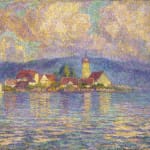Willy Schlobach German-Belgian, 1865-1951
A view of Wasserburg on the Lake Constance , ca. 1920
oil on canvas
51 x 61 cm
Copyright The Artist
The present work painted in 1920 depicts Wasserburg, famous for its picturesque peninsula, on which stands the Church of St George and the Wasserburg Castle on the Lake of Constance....
The present work painted in 1920 depicts Wasserburg, famous for its picturesque peninsula, on which stands the Church of St George and the Wasserburg Castle on the Lake of Constance. The composition is characterised by its treatment of light, and atmospheric effects, demonstrating Schlobach's faithful adherence to his distinctive Belgian style. This composition is one of the most luminous of his oeuvre, given the special use of bright colours.
Schlobach was one of the founding members of Le Cercle des XX, a group of young Belgian avant-garde artists who held annual exhibitions of paintings and decorative arts between 1884 and 1895. By no means uniform in their style or approach, Les XX were greatly influenced by artistic trends in France, particularly the Neo-Impressionist paintings of Seurat and Signac. It was Theo van Rysselberghe, who had lived and worked in Paris, whose knowledge and understanding of the techniques of pointillism were to have a profound influence on the younger generation of Belgian painters. From the late 1880s, Schlobach's work found a new freedom of expression in the strict compositional rigour of the pointillist technique, in which the application of brushstrokes of pure colour creates a delicate effect of light and luminosity. He is best known for his shores and lake landscapes.
Schlobach was one of the founding members of Le Cercle des XX, a group of young Belgian avant-garde artists who held annual exhibitions of paintings and decorative arts between 1884 and 1895. By no means uniform in their style or approach, Les XX were greatly influenced by artistic trends in France, particularly the Neo-Impressionist paintings of Seurat and Signac. It was Theo van Rysselberghe, who had lived and worked in Paris, whose knowledge and understanding of the techniques of pointillism were to have a profound influence on the younger generation of Belgian painters. From the late 1880s, Schlobach's work found a new freedom of expression in the strict compositional rigour of the pointillist technique, in which the application of brushstrokes of pure colour creates a delicate effect of light and luminosity. He is best known for his shores and lake landscapes.




